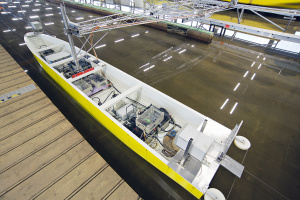Hydraulic Modelling
From BAWiki



In the BAW, representational models are an important method for dealing with various different hydraulic issues relating to the federal waterways. For inland areas, the focus is on complex aspects of spatial current processes and the transport of solid particles, while the issues involved in coastal areas mainly refer to ship dynamic parameters in the context of the interaction between seagoing ships and tidal fairways with corresponding model analysis. Many of the data obtained in the laboratories are necessary for validation and on-going development of the numerical simulation models used in the BAW.
Hydraulic modelling uses system models for principle tests as well as models as detailed reconstruction of river sections or building structures. The BAW has several testing facilities with modern infrastructure. In Karlsruhe for example, a surface area of about 4,500 m² is taken up with modern, fully automatic measurement bridges equipped with extensive photographic measurement systems for widespread recording of changing model geometries and current parameters. Five channels with widths from 0.80 m and 5.00 m and lengths from 20 and 78 m are available for hydraulic and morphological project and research work. A flexible lock test stand on a scale of 1:25 with transparent, movable chamber walls can be adapted to differing chamber widths and filling and draining systems; it is equipped with comprehensive measuring instruments, including a ship force measurement system for measuring the longitudinal and transverse forces of a model ship at the bow and stern.
In Hamburg, the ship wave basin measuring 3,500 m² is used primarily to study the interaction of waterway and seagoing ship, for shallow water dynamic tests, as well as measuring the transverse forces and yaw torques. The studies are carried out with various ship models on a scale of 1:40 (the large dimensions of seagoing ships mean that this scale results in ship models measuring 5 to 10 m in length). The large peripheral channel measuring 200 m in length includes a test section 80 m long shaped as a straight rectangular channel to examine erosion and deposition of natural bed material under tidal current conditions with current velocities of up to 2 m/s.
Click here to see an overview of the available technical equipment.
The commercially available measuring equipment and instrumentation systems used for hydraulic testing are supplemented with special devices and software solutions developed in the BAW. The laboratories are extensively automated and are efficient in operation.
Many of the hydraulic modelling methods used in the BAW are described in detail in the following bulletin.
Literature
- Bundesanstalt für Wasserbau 2007: Mitteilungen Nr. 90, Wasserbauliches Versuchswesen
back to Hydraulic Modelling
